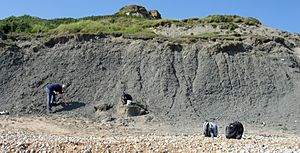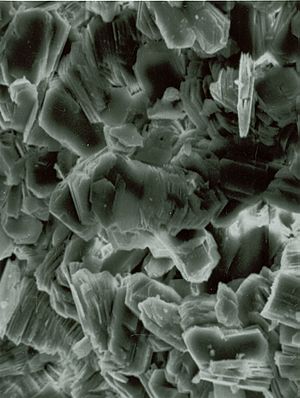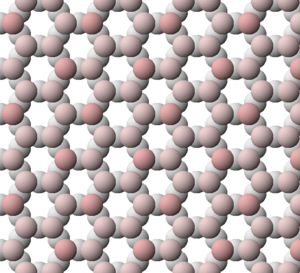Clay mineral facts for kids
Clay minerals are tiny, special types of rocks. They are made mostly of aluminium and silicon, along with water. Sometimes they also contain iron, magnesium, and other elements. You can find them on or near the surface of planets, including Earth.
Clay minerals form when water is present. They have been very important for life on Earth. Some ideas about how life began even involve clay minerals. They are a big part of soil and have been helpful to humans for a long time. People have used them in farming and for making things.
Contents
What are Clay Minerals Like?
Clay is a very fine material found in the ground. When it gets wet, it becomes soft and can be shaped. This is called being plastic. But when it dries or is heated, it becomes hard and strong. Clay is a very common material. It is the oldest known type of ceramic material. People in ancient times discovered how useful clay was and used it to make pottery.
The way clay works, including its ability to hold important nutrients like potassium, is key for healthy soil. Clay particles are super tiny, usually less than 4 micrometers in size. This means you can't see their details with a normal microscope.
Scientists learned more about clay minerals in the 1930s. They used a special method called X-ray crystallography. This method helps them see the tiny crystal structure of clay. They found that clay particles are mostly made of flat, sheet-like minerals. These are similar to the sheets found in mica minerals.
Because clay minerals are so tiny, scientists need special tools to study them. Besides X-ray crystallography, they use other advanced methods. These tools help them identify and understand these important minerals.
Where are Clay Minerals Found?
Clay minerals often form when rocks break down over time. This process is called weathering. They also form when hot water changes other minerals. You can find clay minerals almost everywhere on Earth. They are common in soils. They are also found in fine-grained sedimentary rocks like shale and mudstone. You can also see them in metamorphic rocks such as slate.
Since water is needed for them to form, clay minerals are not very common in the rest of our Solar System. However, they are found a lot on Earth. This is because water has interacted with many other minerals here.
Scientists have found clay minerals in several places on Mars. These include areas like Echus Chasma and Mawrth Vallis. Special instruments have also confirmed their presence on asteroids. These include the dwarf planet Ceres and the comet Tempel 1. They have also been found on Jupiter's moon Europa.
How are Clay Minerals Structured?
Like all sheet-like minerals, clay minerals have flat sheets. These sheets are made of tiny building blocks. One type of block is shaped like a pyramid with four sides, called a tetrahedron. It has one silicon atom in the middle and four oxygen atoms around it. The other block is shaped like an eight-sided figure, called an octahedron. It has an aluminum or magnesium atom in the middle and six oxygen atoms around it.
In clays, these tetrahedral sheets are always connected to octahedral sheets. The way these sheets are stacked creates different types of clay minerals.
Clays can be grouped into two main types based on their layers:
- 1:1 clays: These clays have one tetrahedral sheet connected to one octahedral sheet in each layer. Think of it like a single sandwich.
- 2:1 clays: These clays have one octahedral sheet sandwiched between two tetrahedral sheets. This is like a double-decker sandwich.
The way these sheets connect can make the layers have no electrical charge. Or, they can have a small negative charge. If the layers are charged, other tiny charged particles, called cations, balance this charge. Water can also be found between these layers. The whole crystal structure of clay is made from many of these layers stacked on top of each other.
Types of Clay Minerals
Clay minerals are divided into groups based on their structure. They are either 1:1 or 2:1 clays.
Here are some main groups of clay minerals:
- Kaolin group: This group includes minerals like kaolinite. These are 1:1 clays. Their layers do not have an electrical charge. They are held together by strong bonds between the layers.
- Smectite group: This group includes minerals like montmorillonite. These are 2:1 clays. Their layers have a negative charge. They can hold water and other ions between their layers. In 2013, the Curiosity rover found signs of smectite clay minerals on Mars.
- Illite group: This group includes minerals that are similar to mica. Illite is the most common mineral in this group.
- Chlorite group: This group includes many similar minerals with different chemical makeups. These are also 2:1 clays. Their layers are held together by positively charged octahedral sheets.
- Other 2:1 clays: Some other types exist, like palygorskite and sepiolite. These clays have long channels inside their structure that can hold water.
Clay and the Start of Life
Some scientists believe that clay minerals might have played a role in how life first began on Earth. They think that clay could have helped simple chemicals come together and form more complex molecules, which eventually led to living things.
How Clay is Used in Medicine
Clay minerals have special properties that make them useful in medicine. Because of their shape and charged surfaces, clay can interact with many things. These include medicines, proteins, and even DNA.
Some ways clay is used in medicine are:
- Drug delivery: Clay can help carry medicines to specific parts of the body.
- Tissue engineering: Clay can be used to help grow new tissues or organs.
- Bioprinting: Clay can be part of the materials used to print biological structures.
How Clay is Used in Building
Clay minerals can be added to building materials like mortars. This helps make them stronger. Special types of clay can also be used to make high-quality ceramics. They can also help clean up heavy metals.
Clay can also be used to improve soil. For example, waste clay from making ceramics can help make acidic soil less acidic. This helps plants grow better. Using these waste materials is good for the environment and helps local communities.
See also
 In Spanish: Arcilla para niños
In Spanish: Arcilla para niños




